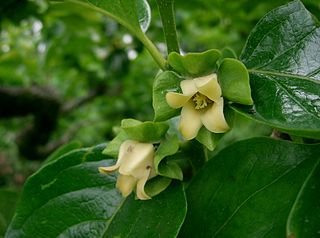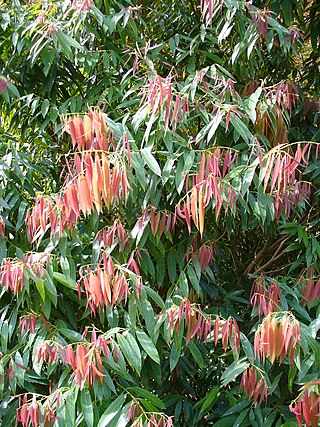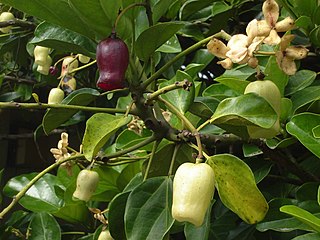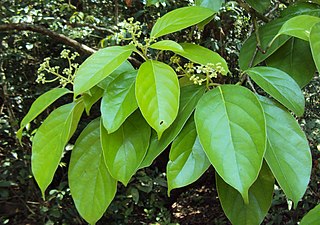
Mangifera is a genus of flowering plants in the cashew family, Anacardiaceae. It contains about 69 species, with the best-known being the common mango. The center of diversity of the genus is in the Malesian ecoregion of Southeast Asia, particularly in Sumatra, Borneo, and the Malay peninsula. They are generally canopy trees in lowland rainforests, reaching a height of 30–40 m (98–131 ft).

Diospyros is a genus of over 700 species of deciduous and evergreen trees and shrubs. The majority are native to the tropics, with only a few species extending into temperate regions. Individual species valued for their hard, heavy, dark timber, are commonly known as ebony trees, while others are valued for their fruit and known as persimmon trees. Some are useful as ornamentals and many are of local ecological importance. Species of this genus are generally dioecious, with separate male and female plants.

Thespesia populnea, commonly known as the portia tree, Pacific rosewood, Indian tulip tree, or milo, among other names, is a species of flowering plant belonging to the mallow family, Malvaceae. It is a tree found commonly on coasts around the world. Although it is confirmed to be native only to the Old World tropics, other authorities consider it to have a wider, possibly pantropical native distribution. It is thought to be an invasive species in Florida and Brazil.

Calophyllum is a genus of tropical flowering plants in the family Calophyllaceae. They are mainly distributed in Asia, with some species in Africa, the Americas, Australasia, and the Pacific Islands.

Mammea is a flowering plant genus with about 70 species in the family Calophyllaceae. Its members are evergreen trees having edible fruits. The flowers are polygamous, with a unitary calyx opening into two or three valvate sepals. There are 4 to 8 petals. Berries are formed, containing 1 to 4 seeds. The leaves are rigid, coriaceous and often have pellucid dots.

Calophyllum inophyllum is a large evergreen plant, commonly called tamanu, oil-nut, mastwood, beach calophyllum or beautyleaf. It is native to tropical Asia and Wallacea. Due to its importance as a source of timber for the traditional shipbuilding of large outrigger ships, it has been spread in prehistoric times by the migrations of the Austronesian peoples to the islands of Oceania and Madagascar, along with other members of the genus Calophyllum. It has since been naturalized in regions in the East African coast. It is also a source of the culturally important tamanu oil.

Sterculia is a genus of flowering plants in the mallow family, Malvaceae: subfamily Sterculioideae. Members of the genus are colloquially known as tropical chestnuts. Sterculia may be monoecious or dioecious, and its flowers unisexual or bisexual.

Mesua is a genus of flowering plants in the family Calophyllaceae, native to tropical southern Asia. Common names include ironwood and rose chestnut.

Endiandra is a genus of about 126 species of plants, mainly trees, in the laurel family Lauraceae. They are commonly called "walnut" despite not being related to the Northern Hemisphere walnuts which are in the family Juglandaceae.

Phoebe is a genus of evergreen trees and shrubs belonging to the Laurel family, Lauraceae. There are 75 accepted species in the genus, distributed in tropical and subtropical Asia and New Guinea. 35 species occur in China, of which 27 are endemic. The first description of the genus was of the type species P. lanceolata made in 1836 by Christian Gottfried Daniel Nees von Esenbeck in Systema Laurinarum, p. 98.

Actinodaphne is an Asian genus of flowering plants in the laurel family (Lauraceae). It contains approximately 125 species of dioecious evergreen trees and shrubs.

Calophyllum soulattri is a species of flowering plant in the Calophyllaceae family. It is found in the Northern Territory of Australia, Brunei, Cambodia, India, Indonesia, Malaysia, the Philippines, Singapore, Sri Lanka, Thailand, and Vietnam. It is considered one of the best bintangor timber species.

Alseodaphne is a genus of plants in the family Lauraceae, endemic to China and Southeast Asia. The genus has 96 species of evergreen trees to shrubs. They have bisexual flowers, a fruit stalk that is red, green, or yellow, and black fruit.

Atuna is a genus of plants in the family Chrysobalanaceae described as a genus in 1838. It is native to the Indian Subcontinent, Southeast Asia, and various islands of the western Pacific.

Beilschmiedia is a genus of trees and shrubs in family Lauraceae. Most of its species grow in tropical climates, but a few of them are native to temperate regions, and they are widespread in tropical Asia, Africa, Madagascar, Australia, New Zealand, North America, Central America, the Caribbean, and South America. The best-known species to gardeners in temperate areas are B. berteroana and B. miersii because of their frost tolerance. Seeds of B. bancroftii were used as a source of food by Australian Aborigines. Timbers of some species are very valuable.

Mastixia is a genus of about 19 species of resinous evergreen trees, usually placed in the family Cornaceae. Its range extends from India through Southeast Asia and New Guinea to the Solomon Islands. Mastixia species have alternate or opposite simple broad leaves, many-flowered inflorescences, and blue to purple drupaceous fruits.
Nothaphoebe is a genus of plant in family Lauraceae. It contains 21 species, which range from mainland Southeast Asia through Indonesia and the Philippines to New Guinea.

Parinari is a genus of plant in the family Chrysobalanaceae.

Calophyllum polyanthum is a species of flowering plant belonging to the genus Calophyllum of the family Calophyllaceae, commonly known as the poonspar tree, sirpoon tree, punnapine, pinnapai, punnappine, kattupunna and malampunna. This tree is native to the Western Ghats in India, where it grows in abundance there. It is also found in Andaman & Nicobar Island, Bangladesh, Bhutan, Laos, Myanmar, Thailand and Vietnam.





















